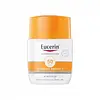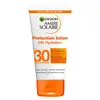What's inside
What's inside
 Key Ingredients
Key Ingredients

 Benefits
Benefits

 Concerns
Concerns

 Ingredients Side-by-side
Ingredients Side-by-side

Water
Skin ConditioningIsopropyl Palmitate
EmollientButylene Glycol Dicaprylate/Dicaprate
EmollientIsodecyl Neopentanoate
EmollientOctocrylene
UV AbsorberAlcohol Denat.
AntimicrobialMethyl Methacrylate Crosspolymer
Butyl Methoxydibenzoylmethane
UV AbsorberDibutyl Adipate
EmollientPhenylbenzimidazole Sulfonic Acid
UV AbsorberBis-Ethylhexyloxyphenol Methoxyphenyl Triazine
Skin ConditioningEthylhexyl Salicylate
UV AbsorberHomosalate
Skin ConditioningGlycine
BufferingPolyamide-5
Skin ConditioningPolymethylsilsesquioxane
Arginine Hcl
Skin ConditioningPolyglyceryl-4 Diisostearate/Polyhydroxystearate/Sebacate
EmulsifyingGlycerin
HumectantSodium Hyaluronate
HumectantGlycyrrhetinic Acid
Skin ConditioningGlycyrrhiza Inflata Root Extract
Skin ConditioningTrisodium EDTA
Silica Dimethyl Silylate
EmollientDimethicone
EmollientEthylhexylglycerin
Skin ConditioningWater, Isopropyl Palmitate, Butylene Glycol Dicaprylate/Dicaprate, Isodecyl Neopentanoate, Octocrylene, Alcohol Denat., Methyl Methacrylate Crosspolymer, Butyl Methoxydibenzoylmethane, Dibutyl Adipate, Phenylbenzimidazole Sulfonic Acid, Bis-Ethylhexyloxyphenol Methoxyphenyl Triazine, Ethylhexyl Salicylate, Homosalate, Glycine, Polyamide-5, Polymethylsilsesquioxane, Arginine Hcl, Polyglyceryl-4 Diisostearate/Polyhydroxystearate/Sebacate, Glycerin, Sodium Hyaluronate, Glycyrrhetinic Acid, Glycyrrhiza Inflata Root Extract, Trisodium EDTA, Silica Dimethyl Silylate, Dimethicone, Ethylhexylglycerin
Water
Skin ConditioningGlycerin
HumectantOctocrylene
UV AbsorberPropylene Glycol
HumectantDiisopropyl Sebacate
EmollientEthylhexyl Salicylate
UV AbsorberAlcohol Denat.
AntimicrobialButyl Methoxydibenzoylmethane
UV AbsorberTitanium Dioxide
Cosmetic ColorantIsohexadecane
EmollientEthylhexyl Triazone
UV AbsorberAluminum Starch Octenylsuccinate
AbsorbentStearic Acid
CleansingTriethanolamine
BufferingPotassium Cetyl Phosphate
EmulsifyingTalc
AbrasiveSynthetic Wax
AbrasiveAscorbyl Glucoside
AntioxidantTocopherol
AntioxidantPhenoxyethanol
PreservativePEG-100 Stearate
Palmitic Acid
EmollientDimethicone
EmollientLimonene
PerfumingXanthan Gum
EmulsifyingBenzyl Salicylate
PerfumingBenzyl Alcohol
PerfumingLinalool
PerfumingCaprylyl Glycol
EmollientTerephthalylidene Dicamphor Sulfonic Acid
UV AbsorberAcrylates/C10-30 Alkyl Acrylate Crosspolymer
Emulsion StabilisingGeraniol
PerfumingDisodium EDTA
Citral
PerfumingCitronellol
PerfumingAluminum Hydroxide
EmollientCoumarin
PerfumingGlyceryl Stearate
EmollientParfum
MaskingWater, Glycerin, Octocrylene, Propylene Glycol, Diisopropyl Sebacate, Ethylhexyl Salicylate, Alcohol Denat., Butyl Methoxydibenzoylmethane, Titanium Dioxide, Isohexadecane, Ethylhexyl Triazone, Aluminum Starch Octenylsuccinate, Stearic Acid, Triethanolamine, Potassium Cetyl Phosphate, Talc, Synthetic Wax, Ascorbyl Glucoside, Tocopherol, Phenoxyethanol, PEG-100 Stearate, Palmitic Acid, Dimethicone, Limonene, Xanthan Gum, Benzyl Salicylate, Benzyl Alcohol, Linalool, Caprylyl Glycol, Terephthalylidene Dicamphor Sulfonic Acid, Acrylates/C10-30 Alkyl Acrylate Crosspolymer, Geraniol, Disodium EDTA, Citral, Citronellol, Aluminum Hydroxide, Coumarin, Glyceryl Stearate, Parfum
 Reviews
Reviews

Ingredients Explained
These ingredients are found in both products.
Ingredients higher up in an ingredient list are typically present in a larger amount.
Alcohol Denat. is an alcohol with a denaturant property. It is created by mixing ethanol with other additives.
This ingredient gets a bad rep because it is irritating and drying - mostly due to its astringent property. Astringents draw out natural oils in tissue, constricting pores and leaving your skin dried out.
However, alcohol denat. is not all that bad.
Due to its low molecular weight, alcohol denat. tends to evaporate quickly. One study on pig skin found half of applied alcohol evaporated in 10 seconds and less than 3% stayed on skin.
This also helps other ingredients become better absorbed upon application.
Studies are conflicted about whether this ingredient causes skin dehydration. One study from 2005 found adding emollients to propanol-based sanitizer decreased skin dryness and irritation. Another study found irritation only occurs if your skin is already damaged.
Small amounts of alcohol are generally tolerated by oily skin or people who live in humid environments.
The rule of thumb is if this alcohol is near the end of an ingredients list, it will probably not affect your skin much.
Also...
This ingredient has antimicrobial and solvent properties.
The antimicrobial property helps preserve products and increase their shelf life. As a solvent, it helps dissolve other ingredients.
Other types of astringent alcohols include:
Learn more about Alcohol Denat.Also known as Avobenzone, this ingredient is a chemical sunscreen filter that provides protection in the UV-A range.
Avobenzone is globally approved and is the most commonly used UV-A filter in the world.
Studies have found that avobenzone becomes ineffective when exposed to UV light (it is not photostable; meaning that it breaks down in sunlight). Because of this, formulations that include avobenzone will usually contain stabilizers such as octocrylene.
However, some modern formulations (looking at you, EU!) are able to stabilize avobenzone by coating the molecules.
Avobenzone does not protect against the UV-B range, so it's important to check that the sunscreen you're using contains other UV filters that do!
The highest concentration of avobenzone permitted is 3% in the US, and 5% in the EU.
Learn more about Butyl MethoxydibenzoylmethaneDimethicone is a type of synthetic silicone created from natural materials such as quartz.
What it does:
Dimethicone comes in different viscosities:
Depending on the viscosity, dimethicone has different properties.
Ingredients lists don't always show which type is used, so we recommend reaching out to the brand if you have questions about the viscosity.
This ingredient is unlikely to cause irritation because it does not get absorbed into skin. However, people with silicone allergies should be careful about using this ingredient.
Note: Dimethicone may contribute to pilling. This is because it is not oil or water soluble, so pilling may occur when layered with products. When mixed with heavy oils in a formula, the outcome is also quite greasy.
Learn more about DimethiconeEthylhexyl Salicylate is an organic compound used to block UV rays. It primarily absorbs UVB rays but offers a small amount of UVA protection as well.
Commonly found in sunscreens, Ethylhexyl Salicylate is created from salicylic acid and 2-ethylhexanol. You might know salicylic acid as the effective acne fighter ingredient and BHA.
The ethylhexanol in this ingredient is a fatty alcohol and helps hydrate your skin, similar to oils. It is an emollient, which means it traps moisture into the skin.
According to manufacturers, Ethylhexyl Salicylate absorbs UV wavelength of 295-315 nm, with a peak absorption at 307-310 nm. UVA rays are linked to long term skin damage, such as hyperpigmentation. UVB rays emit more energy and are capable of damaging our DNA. UVB rays cause sunburn.
Learn more about Ethylhexyl SalicylateGlycerin is already naturally found in your skin. It helps moisturize and protect your skin.
A study from 2016 found glycerin to be more effective as a humectant than AHAs and hyaluronic acid.
As a humectant, it helps the skin stay hydrated by pulling moisture to your skin. The low molecular weight of glycerin allows it to pull moisture into the deeper layers of your skin.
Hydrated skin improves your skin barrier; Your skin barrier helps protect against irritants and bacteria.
Glycerin has also been found to have antimicrobial and antiviral properties. Due to these properties, glycerin is often used in wound and burn treatments.
In cosmetics, glycerin is usually derived from plants such as soybean or palm. However, it can also be sourced from animals, such as tallow or animal fat.
This ingredient is organic, colorless, odorless, and non-toxic.
Glycerin is the name for this ingredient in American English. British English uses Glycerol/Glycerine.
Learn more about GlycerinOctocrylene protects skin from sun damage. It absorbs UV-B with peak absorption of 304 nm. It is a common sunscreen ingredient and often paired with avobenzone, a UVA filter. This is because octocrylene stabilizes other sunscreen ingredients by protecting them from degradation when exposed to sunlight. Octocrylene is a photostable ingredient and loses about 10% of SPF in 95 minutes.
Octocrylene also acts as an emollient, meaning it helps skin retain moisture and softens skin. It is oil-soluble and hydrophobic, enhancing water-resistant properties in a product.
Those who are using ketoprofen, a topical anti-inflammatory drug, may experience an allergic reaction when using octocrylene. It is best to speak with a healthcare professional about using sunscreens with octocrylene.
The EU allows a maximum of these concentrations:
Learn more about OctocryleneWater. It's the most common cosmetic ingredient of all. You'll usually see it at the top of ingredient lists, meaning that it makes up the largest part of the product.
So why is it so popular? Water most often acts as a solvent - this means that it helps dissolve other ingredients into the formulation.
You'll also recognize water as that liquid we all need to stay alive. If you see this, drink a glass of water. Stay hydrated!
Learn more about Water